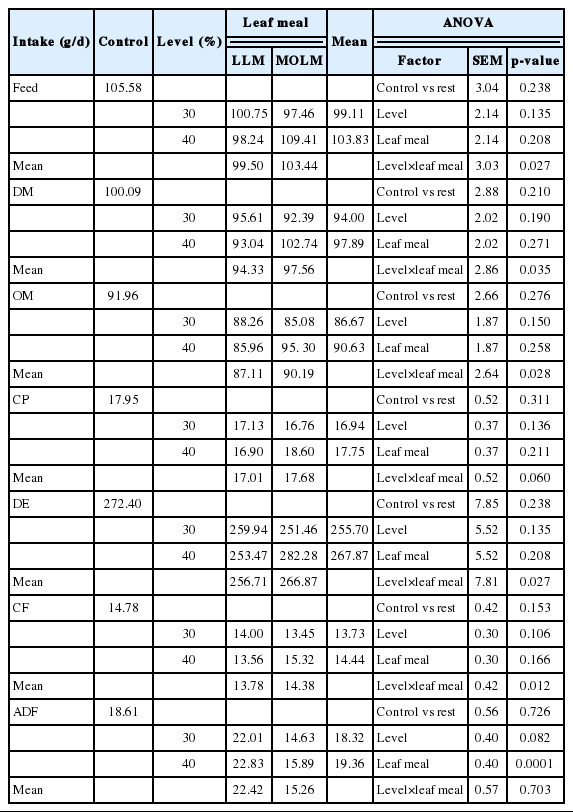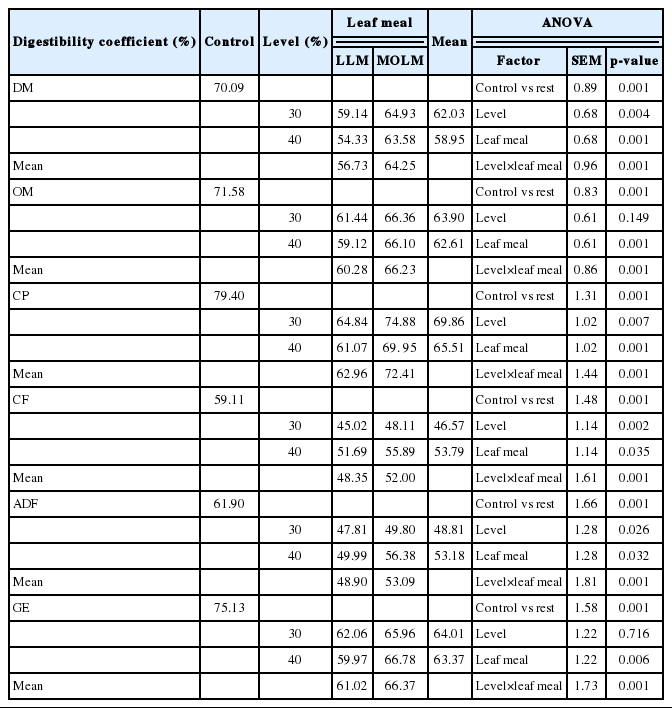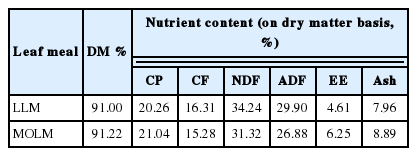Estimating Apparent Nutrient Digestibility of Diets Containing Leucaena leucocephala or Moringa oleifera Leaf Meals for Growing Rabbits by Two Methods
Article information
Abstract
This study aimed to evaluate the nutrient digestibility of growing rabbits fed diets with different levels of either Leucaena leucocephala (LLM) or Moringa oleifera (MOLM) leaf meals and also to compare total collection and TiO2 marker methods for estimating digestibility. A total of 30 California growing rabbits (1.81±0.19 kg live weight on average) were randomly distributed into five experimental groups of six rabbits each and were housed in individual cages. The groups were control, 30% LLM, 40% LLM, 30% MOLM, and 40% MOLM. All groups received pelleted diets for two weeks; diets also contained 4 g/kg titanium dioxide as dietary marker. Daily feed intake was recorded during the whole experimental period and total feces were collected daily and weighed individually during four days. The results showed that there were no difference (p>0.05) in feed, dry matter (DM), organic matter (OM), crude protein (CP), digestible energy, and crude fiber (CF) intake between the control group and the other experimental groups. The apparent digestibility values of DM, OM, CP, CF, acid detergent fiber, and gross energy were the highest for control group (p = 0.001), meanwhile MOLM diets had generally higher nutrient digestibility coefficients than LLM diets. Increasing the inclusion level of leaf meal in the diet from 30% to 40% improved the digestibility of CF from 45.02% to 51.69% for LLM and from 48.11% to 55.89% for MOLM. Similar results for apparent nutrient digestibility coefficients were obtained when either total collection or indigestible marker method was used. In conclusion, the digestibility of MOLM containing diets were better than LLM diets, furthermore TiO2 as an external marker could be used as a simple, practical and reliable method to estimate nutrients digestibility in rabbit diets.
INTRODUCTION
The shortage of animal protein for human consumption, especially in developing countries, may be attributed to the declining animal protein production occasioned by high cost of livestock production, mainly the cost of feeds which usually accounts for up to 70% of the total production cost (Ajayi et al., 2007). Therefore, any reduction in feed cost will reduce remarkably the total production costs. The use of leaf meals could help in alleviating the competition between humans and animals for some conventional feedstuffs, such as soybean meal and maize (Al-Harthi et al., 2009)
Leucaena leucocephala (LLM) and Moringa oleifera (MOLM) are among the leaf meals that could be used as feed alternatives for commercial livestock in the tropics (Abou-Elezz et al., 2011). The LLM and MOLM are distinguished by their high protein contents, which range from 20% to 34% crude protein (CP) in LLM, and 20% to 29% in MOLM on dry matter basis; additionally they have an acceptable profile of essential amino acids, vitamins and minerals (Odetola et al., 2012).
As reported by Gidenne (2000) the rabbit has a low utilization of the fibrous fraction due to the rapid passage of feed through the gastrointestinal tract. However through the caecotrophic activity, the digestibility of nutrients, especially protein, is incremented (Machado et al., 2012).
Measuring digestibility is a way to evaluate the availability of nutrients. The in vivo digestibility of nutrients can be measured directly and indirectly; directly by precisely recording feed intake and fecal excretion of an animal subjected to dietary treatment in a given time period. The disadvantage of this method is the probable contamination of excreta and urine and the collection is not always accurate. The indirect way to measure the digestibility does not require quantifying consumption but a marker as fecal excretion could be added or included in the feed (Nieves et al., 2008; Bovera et al., 2012; 2013). The advantage of this method is that it saves labor, compared to the total collection method.
Concerning feeding experiments, the European Group on Rabbit Nutrition adopted a common reference of total fecal collection method for in vivo determination of apparent diet digestibility (Perez et al., 1995).
The external marker (such as titanium dioxide, chromium oxide and rare-earth elements) needs to be recoverable, indigestible, and not adsorbed. Additionally, it should have no effect on the animal or on digestibility and also, not occurring in the diet or in the soil (Pereira et al., 2004).
There are plenty of fibrous feedstuffs that can be included into rabbit diets. However, their level of inclusion is often strongly limited due to the little information available about their nutritive value and total mean retention time, and the nutrients unbalance that they might present.
The aim of this paper was to estimate the nutrient apparent digestibility of diets containing either LLM or MOLM leaf meals for growing rabbits and to compare the direct (total collection of feces) and indirect (titanium dioxide as an external marker) methods for determining in vivo digestibility of diets containing those tropical forages.
MATERIALS AND METHODS
Study site
The study was carried out at the rabbit facility of the Faculty of Veterinary Medicine and Animal Science (FMVZ), University of Yucatan (UADY), Merida, Yucatan, Mexico. The climate is sub-humid, with an average annual rainfall (highly variable) of 960 mm, and 6 to 7 months of dry period; the annual average temperature is 26°C. The daily average is 23°C (max. 32°C, min. 15°C); while from March to September it is 30°C (max. 37°C, min. 23°C) as reported by Safwat et al. (2014).
Animals, treatments and experimental design
A total of 30 unsexed growing California rabbits (11 wk of age and 1.81±0.19 kg live weight on average) were allocated to individual cages (40×40×50 cm), unsexed rabbits were used in this study because there is no significant difference between male and female concerning nutrient intake and digestibility (Salisu and Iyeghe-Erakpotobor, 2014). Rabbits were randomly divided into five equal groups each of six animals; the animals were assigned to five dietary treatments containing 30% LLM, 40% LLM, 30% MOLM, and 40% MOLM, the control group did not contain LLM or MOLM. All groups received diets in the form of pellets. The experimental diets were offered daily and fresh water was provided all the time. The composition and chemical analyses of all experimental diets are shown in Table 1.
Preparing the leaf meals
L. leucocephala and M. oleifera fresh leaves were harvested from trees (2 to 4 year old, last harvest was 4 months before) growing at the FMVZ farm, under the tropical conditions of the Yucatán Peninsula. As described by Abou-Elezz et al. (2011), the young branches were cut from trees; leaves were separated from branches, spread out and dried under shade for a period of 1 d. Thereafter, they were dried in ovens (60°C) for two days. The dried leaves were grounded with a hammer mill (3.0 mm sieve) to make the LLM or MOLM, which were incorporated to the experimental diets. The chemical analysis of leaf meals is shown in Table 2.
Digestibility study
The animals were housed individually in metabolic cages (40×50×50 cm) which allow separation of faeces and urine; each cage was equipped with an automatic drinker nipple and a manual feeder. The experimental period lasted 14 d, feed consumption was accurately determined daily during the whole experimental period and feces were collected for four days as a collection period (Perez et al., 1995); the collection was performed at approximately 09:00 h each morning before the next daily ration was provided, and then the feces were dried at 60°C for 24 h. All collected feces for each animal were mixed, then representative feces samples were ground for chemical analyses. The apparent coefficients of nutrient digestibility were determined using two different methods (direct and indirect method).
Total collection (direct method)
The standard method is fully described by Perez et al. (1995). The apparent nutrient digestibility coefficients of the diets were determined according to the classical formula:
Where, NI represented the nutrient intake and NE expressed the nutrient excreted.
Indigestible marker (indirect method)
Titanium dioxide (TiO2) was added at 4 g/kg to all diets during mixing as an external marker. Collection period lasted also four d preceded by 72 h of diet consumption to ensure marker distribution all over the gastrointestinal tract. The apparent digestibility of dry matter (DM) and nutrients were calculated using the nutrient-to-marker ratio in the diet and feces according to the following equation of Ravindran et al. (1999):
Where TiO2 represents the concentration of titanium dioxide; and N is the nutrient concentration.
Chemical composition
Laboratory analyses were carried out on feed, leaf meals and fecal samples using the standard AOAC (1995) procedures to determine DM, organic matter (OM), CP, and crude fiber (CF) content. For neutral detergent fiber and acid detergent fiber (ADF) sequential method was performed according to Van Soest et al. (1991). The TiO2 was determined using a photometrical determination method (Boguhn et al., 2009). Gross energy (GE) was determined using an adiabatic bomb calorimeter (Parr-328, Parr Instruments Co., Moline, IL, USA).
Statistical analysis
Diet digestibility and nutrients intake were analyzed using the general linear model option of the analysis of variance software of SAS 9.2 program (SAS Institute, Cary, NC, USA). Orthogonal contrasts were utilized to evaluate differences between the control group vs the other experimental groups; thereafter data were analyzed as a 2×2 factorial arrangements (without including the control group) in order to evaluate the effects of leaf meals (LLM vs MOLM), level of inclusion (30% vs 40%) and the interaction. Treatment effects were considered significant at p≤0.05.
In addition, as both axis (method) x and y have error, orthogonal regression analysis was used to compare the results between the two methods and assess the value of TiO2 method to estimate digestibility by total collection. Thus, the TiO2 marker method was considered the predictor for the total collection method for each nutrient digestibility. The error variance ratio (σ Total collection/σ TiO2) was estimated for each nutrient fraction and included in the orthogonal regression analysis using Minitab 16 software (2009).
RESULTS
The results showed considerable amounts of CP and CF in the leaf meals being 20.26% and 16.315 for LLM and 21.04% and 15.28% for MOLM, respectively. In addition, LLM has higher ADF content (29.90%) than MOLM which contains 26.88% (Table 2).
Data in Table 3 revealed that no significant differences (p>0.05) were detected between the control group and the other experimental groups concerning feed and nutrients intake. Increasing the inclusion level of leaf meals in the diet from 30% to 40% resulted in a significant level×leaf meal interaction (p 0.05); there was lower intake of feed, DM, OM, digestible energy (DE), and CF by increasing LLM in the diet but higher intake of those parameters by increasing MOLM inclusion level. The amounts of daily ADF consumed by rabbits were higher (p = 0.0001) for LLM treatments than MOLM treatments.

Feed and nutrients intake of growing rabbits fed diets contained Leucaena leucocephala (LLM) or Moringa oleifera (MOLM) leaf meals (n = 6 rabbits for each mean)
The results of apparent nutrients digestibility for growing rabbits fed diets containing different levels of LLM and MOLM using TiO2 marker method are presented in Table 4. The results revealed that the control group had the highest digestibility coefficient values of DM, OM, CP, CF, ADF, and GE (p = 0.001); while the MOLM diets had generally higher nutrient digestibility coefficients (p<0.05) than LLM diets. Unlike the DM, OM, and CP digestibility of both leaf meals, it can be observed that the CF and ADF digestibility improved by increasing the level of leaf meal (p<0.03), being 14.82% and 16.17% higher for LLM treatments as well as 4.56% and 13.21% higher for MOLM treatments when the inclusion level increased from 30% to 40% for CF and ADF, respectively.

Apparent nutrients digestibility (%) of growing rabbits fed diets contained Leucaena leucocephala (LLM) or Moringa oleifera (MOLM) leaf meals using TiO2 marker method (n = 6 rabbits for each mean)
Table 5 shows the orthogonal regression coefficients to estimate apparent nutrients digestibility of the total collection method by the external marker method (TiO2). There were no significant differences between the two different methods in their estimations of apparent nutrient digestibility coefficients. In all cases the intercept (a) was not different (p>0.05) from 0, while the 95% confidence interval of the slopes (b) always included 1 (p<0.05) in all chemical fractions. Additionally, the variance of error ratio between the two methods was for all nutrients around 1 denoting similar variances for both methods.
DISCUSSION
The lower feed and nutrients intake as well as apparent digestibility values recorded for rabbits fed LLM treatments can be attributed to the possible effect of the anti-nutritional compounds such as mimosine and tannins present in L. leucocephala (Simon, 2012), these compounds tend to decrease diet digestibility through their ability to bind with proteins and other nutrients, resulting in decreased diet intake (Al Mamary et al., 2001). Such result agreed with the findings obtained by Nieves et al. (2002) who mentioned lower DM, OM, and CP digestibility coefficients of LLM diets than the control diet. Meanwhile, the high nutrients intake and digestibility values of MOLM treatments may be due to the low anti-nutritional compounds of M. oleifera along with their highly digestible nature which reported by Nuhu (2010). In addition, Fahey et al. (2001) indicated that MOLM is an outstanding indigenous source of highly digestible protein.
The high ADF intake associated with the LLM groups is mainly because of the high ADF content of their diets (Table 1). The present study produced a range of daily feed intake which was generally in the recorded range of 61.08 to 133.9 g earlier reported for rabbits (Ayers et al., 1996; Okorie, 2003).
The observed increment of dietary fiber digestibility with increasing the inclusion level of leaf meals in the diets could possibly be due to the balance of dietary fiber fractions in terms of the proportions of cellulose, hemicellulose and lignin from the leaf meals and hence an improvement of fiber digestive capacity. This result is in agreement with the data of Sarwatt et al. (2003) who observed higher CF digestibility for diets having leaf meals than for the control diet.
The digestibility coefficient for DM, CP, CF, and GE (Table 4) found in the present experiment were generally in the ranges of 55.72% to 78.4% for DM, 59.0% to 87.8% for CP, 13.9% to 55.0% for CF and 59.05% to 79.96% for GE reported earlier in the tropics (Chiou et al., 1998; Sarwatt et al., 2003; Nieves et al., 2008; Nuhu, 2010).
The estimated DE from the analyzed GE values using the digestibility coefficient of GE were 3,103, 2,581, 2,553, 2,634, and 2,652 kcal DE/kg DM for the control, 30% LLM, 40% LLM, 30% MOLM, and 40% MOLM diets, respectively. Comparing these results with the calculated DE values for all experimental diets (2,580 kcal DE/kg DM) presented in Table 1 which were calculated from DE content of each ingredient, it can be noticed that estimated results were nearly similar to the calculated values except for the control diet which was overestimated (3,103 vs 2,580 kcal DE/kg DM). This could be related to the high digestibility of alfalfa hay which was included at a high proportion in the control diet, in addition the calculation sometimes fails to consider food associative effects (positive interactions in this case) which can influence whole diet digestibility (Calabro et al., 1999).
Although it has been reported previously that DM (Pereira et al., 2004) and nutrient digestibility (Nieves et al., 2008) could be estimated with similar results either by an external marker or total collection method no complete statistical validation has been presented before the current report. The results from this study showed that the digestibility of nutrients in rabbit diets determined either by the total collection method or by titanium dioxide method (external marker) yields similar results (Table 5). The validation performed in the present work for the use of TiO2 not only for DM but also for all feed fractions will result in a significant reduction in work associated with digestibility trials.
CONCLUSION
The intake and nutrients digestibility coefficients obtained show an interesting potential inclusion for M. oleifera leaf meal in the diets of growing rabbits up to 40%, since diets contained M. oleifera leaf meal were more digestible than diets containing the same levels of L. leucocephala leaf meal. It can be also concluded that the titanium dioxide as an external marker could be alternatively used as a practical, reliable and applicable method to replace the total collection method in estimation of nutrients digestibility in rabbit diets.
ACKNOWLEDGMENTS
This research work was partially funded by the scholarship awarded to the first author by the government of Mexico through the Secretaría de Relaciones Exteriores (SRE).


